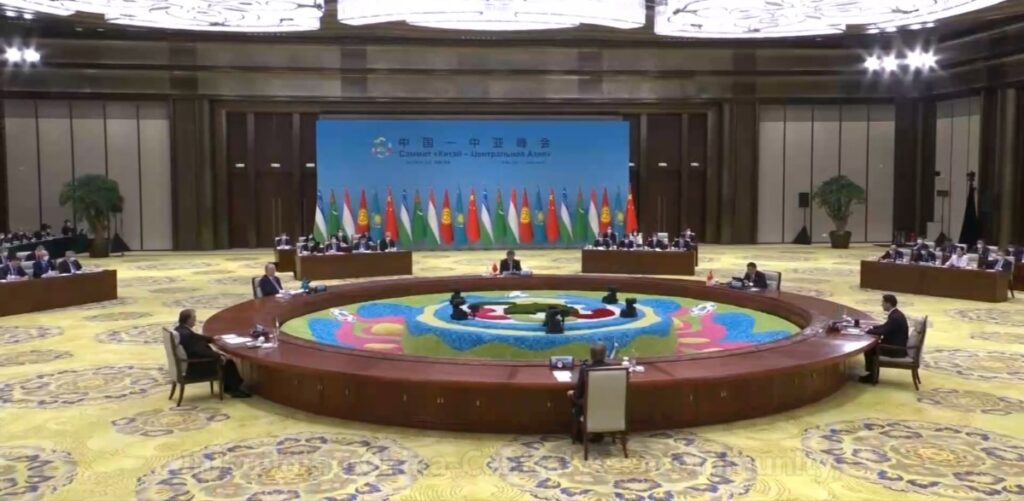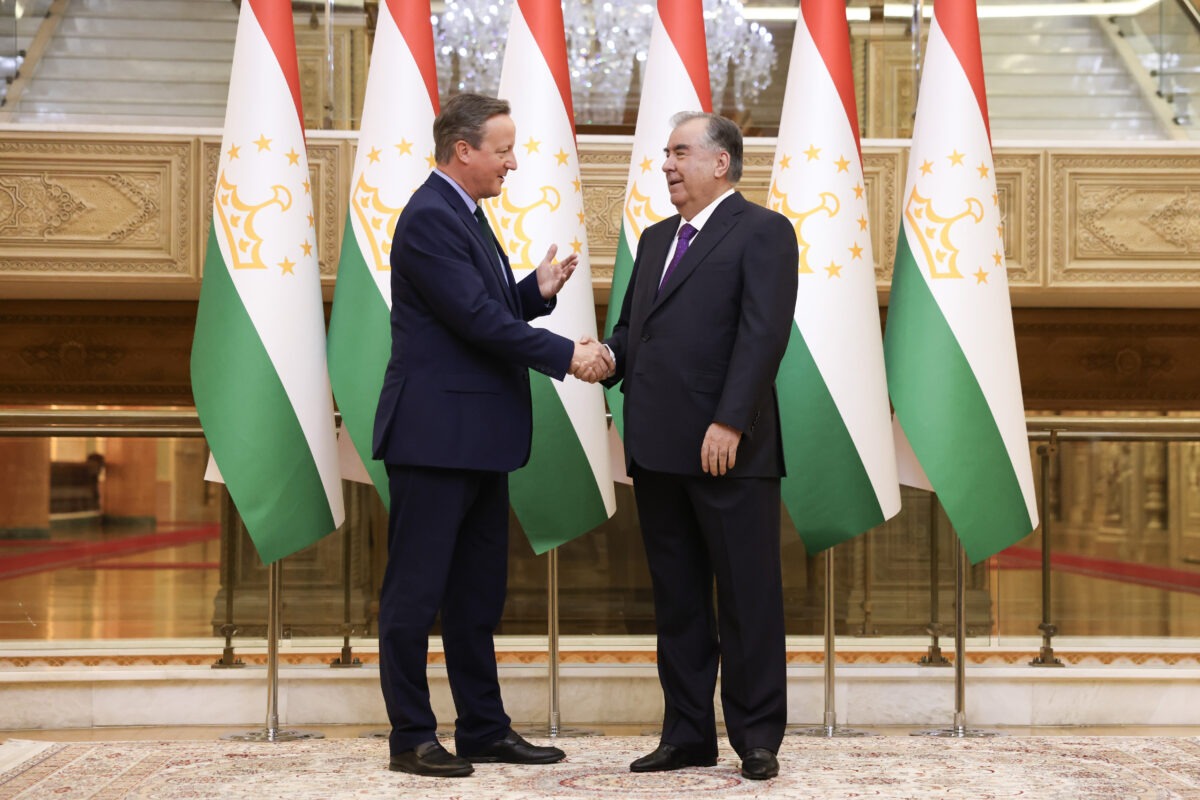
In April, British foreign minister and former prime minister David Cameron travelled to all five Central Asian republics – Kazakhstan, Kyrgyzstan, Uzbekistan, Tajikistan, and Turkmenistan – plus Mongolia, with the goal of reinforcing Western influence in the region. While in Britain much of the coverage has focused on Cameron’s decision to burn £42 million in taxpayer money by travelling in a luxury jet, the foreign minister’s sojourn to the Stans in fact shows the region’s growing importance to Western powers as the new Cold War intensifies.
In November 2023, the UK parliament published a report titled Countries at crossroads: UK engagement in Central Asia. The report asserts that “deepening UK engagement in Central Asia…should be seen as a geopolitical imperative.” It specifically identifies China and Russia as oppositional forces in the region: “The UK’s response to the manoeuvring of Russia, China and others can have a significant impact on the economic and political independence of Central Asian countries.”
The British government’s preoccupation with China and Russia’s activities in Central Asia is obvious. Indeed, the 67-page report mentions China 37 times and Russia 118 times.
A risk and intelligence company quoted in the report, KCS Group, claims Britain “must have the confidence to openly set itself against Russia and China [in Central Asia] and the commitment to not back down should either of those, or domestic lobbies within Central Asia, begin to fight back.”
At the same time, the report notes that Britain should not try to “supplant or out-compete China or Russia” in Central Asia, but instead provide “different options to Central Asian leadership.” Given the report’s obviously geopolitical nature, it is clear that the UK will only present “different options” if they align with British foreign policy goals, i.e., sidelining the West’s geopolitical foes. This is the context in which Cameron’s Central Asia trip took place.
Washington’s goals in the region are the same. A February 2020 report from the State Department, titled United States Strategy for Central Asia, 2019-2025, notes that “Central Asia is a geostrategic region important to United States national security interests, regardless of the level of United States involvement in Afghanistan.”
This document, published before Russia’s invasion of Ukraine, does not name either Moscow or Beijing as competitors in the region, although they are notable by their absence. The report clearly stresses that US policy in Central Asia aims at deepening both American and European investment in the region: “We will work to ensure the countries of the region are increasingly better connected to Europe through the Caucasus, to Afghanistan and South Asia, as well as to global markets.”
Ottawa also recognizes the geopolitical importance of strengthening ties with Central Asia.
Even before the invasion of Ukraine, Canadian parliament identified Russian interests in the region as oppositional to the US and its Western allies. A 2017 report from the Standing Committee on Foreign Affairs and International Development, titled Strengthening Canadian Engagement in Eastern Europe and Central Asia, notes that “relations between the West and Russia are arguably at their lowest point since the Cold War.” One section of the report, titled “Competing Regional Interests between the West and Russia,” makes clear that, long before 2017, Russia viewed Western actions in Central Asia as provocative and deliberately intended to undermine Moscow’s interests.
Interestingly, the report quotes analysts who recall that post-communist Russia was initially very drawn to NATO and the EU, but soon came to view these organizations as “antagonistic, aimed at limiting Moscow’s influence in its neighborhood.”
The government report notes: “Some witnesses suggested that Russia’s efforts to assert its regional influence are defensive in nature and largely misunderstood. According to this minority perspective, Russia increasingly feels encircled by its former Cold War adversaries and believes that the West has deliberately enlarged NATO to Russia’s borders.” It quotes Christopher Westdal, former Canadian ambassador to Russia and to Ukraine, as saying: “Call Russia’s reaction ‘aggression,’ if you will, but as we grew NATO by leaps and bounds, what did we expect? … That Russia would just roll over in the face of an obvious strategic calamity…?”
The Standing Committee report makes a number of suggestions, including that Ottawa should keep pressuring Russia in Eastern Europe and Central Asia while promoting Canadian business investment in both areas.
Fast forward to the present, and Western efforts to court Central Asian governments have only escalated. French president Emmanuel Macron visited Kazakhstan and Uzbekistan in 2023. US Secretary of State Antony Blinken toured all five republics that same year, and according to long-time Central Asia correspondent Bruce Pannier, his message to the region’s leaders amounted to “Less Russia, not too much China.” Now David Cameron has ventured to the Stans. These Western officials all made various promises of investment and bilateral cooperation.

These visits by Western officials are unprecedented in recent decades. Macron was the first French president to visit the region since 1994. Cameron was the first foreign minister to visit Uzbekistan since 1997, and the first ever to visit Turkmenistan, Tajikistan, and Kyrgyzstan.
For the US, however, Central Asia has long been geopolitically vital. Washington’s decision in the 1970s to arm the mujahideen in Afghanistan was done on the assumption that weakening the Soviet Union’s Central Asian flank would deplete the USSR as a whole.
Following the collapse of the Soviet Union, the US built military bases in Kyrgyzstan and Uzbekistan, while in Kazakhstan, Chevron found lucrative oil deposits to exploit and a repressive government to help exploit them. In 2005, the US supported the overthrow of Askar Akayev, the first president of independent Kyrgyzstan, after Akayev fell out of favor with Washington, in part because of his deepening ties with Russia and China.
Under the Trump administration, Secretary of State Mike Pompeo visited the region and urged Central Asian countries to be wary of Russian and Chinese investment. From Kazakhstan, he called on “all countries to join us in pressing for an immediate end” to alleged human rights abuses in China.
Russian and Chinese commitments to Central Asia have only grown since then, while comparatively, the collective West has lagged.
China’s trade with the Central Asian states hit $89.4 billion in 2023, up 27 percent from 2022. As Conor Gallagher writes: “The total value for Chinese projects in Central Asia is more than $63 billion. Russia, too, plays a major role in the Central Asian economies, including the construction of nuclear power plants, thermal and hydropower plants, as well as the export of oil, gas, electricity, and wheat.”
It is common to hear that Russian influence in Central Asia is waning, but as Foreign Policy contributors Raffaello Pantucci and Alessandro Arduino explain, this isn’t the case:
Money flows from Russia into the region have increased. More companies are moving to the region, as foreign and Russian entities and men seeking to escape the Kremlin’s mobilization drive and find an accommodating environment in Central Asia. The Russian government has also leaned heavily into its relationship with the region, with Russian President Vladimir Putin visiting all five countries and sending numerous high-level delegations to seek business links and opportunities. New schools, equipment, aid, and general rhetorical support have also flowed from Moscow.
Even so, the fallout from the war in Ukraine has caused some in Central Asia to view Russia with greater suspicion. In an October 2023 interview, a representative from the leftist KyrgSoc (Kyrgyzstan Socialism) organization stated that “Russia is losing its former dominant position in Kyrgyzstan… More and more people begin to perceive Russia not as a ‘big brother’/ally of sorts, but as one of the distant foreign states, a foreign country. The war in Ukraine has only accelerated this process of alienation from Russia.” They added: “Most likely, China will take the place of ‘big brother.’”
Baiel Isayev, a KyrgSoc member, argues that Russia invests in Kyrgyzstan to “improve [Russia’s] image and further exploit Kyrgyzstan as its sales market and a source of cheap labor.” By contrast, he asserts that China “acts pragmatically… preferring financial to political influence. [China] gives out loans, builds infrastructure and other facilities on credit, and buys the right to process and extract mines.”
Despite this shift in attitude toward Russia by some in Central Asia, Russia remains a dominant player in the region, alongside China. The US simply can’t compete. As the RAND Corporation notes: “Because the United States is unlikely to outspend China or even Russia, its approach needs to be deliberate and focused on areas where it can see the greatest return on investment.”
The scale of Russian-Chinese integration with Central Asia is vastly outpacing the US. Not only have Russia and China expanded their bilateral trade relationship, especially for energy, since early 2022, but heightened tensions with the West have spurred both countries to deepen trade ties with Central Asia as a way to withstand Western isolation efforts. Gallagher explains:
Russia and China are also both working to solidify friendly governments in Central Asia, thereby securing and rapidly expanding land supply chains through the region… Russia, China, and Kazakhstan also just announced an initiative to improve their transport and logistics infrastructure, including a direct transport link connecting Xi’an with Moscow. The Southern Transport Corridor is an example of a plan to hedge against any efforts of “deterrence” by the West. The route, which will connect Russia, Turkmenistan, Uzbekistan, Kyrgyzstan, and China via the Caspian Sea, could be viewed as a contingency plan in case the shorter Kazakhstan connection is disrupted.
At a May 2023 meeting with Central Asian leaders in the Chinese city of Xi’an, China and Kazakhstan signed 23 bilateral agreements; China and Uzbekistan signed 41; China and Kyrgyzstan signed 25; China and Tajikistan signed 25; and China and Turkmenistan signed at least six, a smaller number, but still significant when one recalls that the two countries signed 15 agreements in January 2023.

There were also reports last year that Russia and China are negotiating new platforms to coordinate and synthesize their investments in the region, specifically through a proposed organization called “5+2.” As the Russian newspaper Nezavisimaya Gazeta reported, “a new ‘5+2’ axis is being formed (Central Asia plus China and Russia),” a platform which former Indian diplomat M.K. Bhadrakumar writes:
will have its own mechanisms and projections, which differ from the Shanghai Cooperation Organisation (SCO) or the Belt and Road Initiative and the Eurasian Economic Union community…Currently, there are no agreed common strategies in the Central Asian region, which has a population of 75 million. The Belt and Road project does not adequately take into account the interests of Russia and the interface with the Eurasian Economic Union projects cannot provide a sufficient level of interaction either, due to systemic weaknesses.
While Russian investments in Central Asia remain sizeable, the impact of sanctions has frayed interconnectivity somewhat, and as a result, China has become the region’s largest trading partner. It seems that China strikes a suite of new agreements in Central Asia every month. In March 2024, Kazakhstan’s National Chamber of Entrepreneurs signed a memorandum of cooperation with the Chinese government in an effort to boost bilateral trade. In early April, the Chinese mining company Huaxin signed a deal to develop the Kol-Jangak coal field in Kyrgyzstan. China is also deepening its security collaboration with Uzbekistan.
In the context of the new Cold War, China clearly feels well-positioned, not just in Central Asia but globally. On a recent call between Xi Jinping and President Joe Biden, Xi reportedly said that China “will not sit idly by” as the US “insists on suppressing China’s high-tech development and depriving China of its legitimate right to development.”
Meanwhile, US and NATO officials have blamed China for propping up Russia’s military industrial base. When pressed on China-Russia relations, Xi reportedly replied with an aphorism: “Let he who tied the bell on the tiger’s neck take it off,” referencing the Chinese position that the US and NATO are responsible for the situation in Ukraine deteriorating to such a dire point. Xi also reiterated Beijing’s concerns over Washington’s continued military relationship with Taiwan, stating, “If the Taiwan issue is not handled properly, it will have a subversive impact on the relationship between [our] two countries.”
As tensions rise between East and West, with Ukraine and Taiwan two obvious flashpoints, the Central Asian region only grows in importance. For the West, it is a geopolitically significant region on Russia’s doorstep and source of critical resources; for the East, it is a central hub of trade connectivity.
Some observers believe that continued Russian investment, and rising Chinese investment, has moved Central Asia away from its “multi-vectoral” foreign policy approach, by which the region’s leaders tried to strike a balancing act between East and West. Worries that Central Asia is moving closer to Russia and China surely incited the recent spate of diplomatic visits from Western officials including Blinken, Macron, and Cameron.
These visits, however, do not alter the most important fact: in terms of economic power and cultural ties, the West cannot match Russia and China in Central Asia. As the new Cold War intensifies, Western efforts to haul the region into its orbit may ultimately prove dangerous.

Owen Schalk is a writer from rural Manitoba. He is the author of Canada in Afghanistan: A story of military, diplomatic, political and media failure, 2003-2023 and the co-author of Canada’s Long Fight Against Democracy with Yves Engler.

